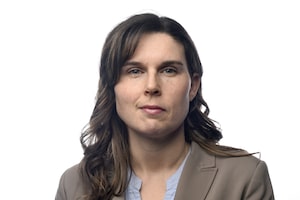Late on a Saturday night in the narrow back hallways of Toronto's Varsity Arena, Canadian hockey Olympian Caroline Ouellette jogged and stretched alongside her Montreal Stars teammates. There were no corners cut in the elite players' postgame routine, even though they would spend 12 hours on a bus that weekend and play two games before a few hundred people.
A few blocks east of the rink, holiday shoppers and bar-goers packed Toronto's Bloor Street, few if any realizing some of the world's best female hockey players were on display minutes away for $8 a ticket. The Stars earned a 4-3 comeback win over the Brampton Hockey Club in a game full of the same women who won gold in Vancouver before the eyes of millions.
That's life in the Canadian Women's Hockey League, the premier post-university playing ground for the sport's elite women, including Olympic and world champions like Canadians Gillian Apps, Tessa Bonhomme and Jayna Hefford, and American star Angela Ruggiero. Progress is slow for the league that started five years ago, and the NHL has yet to respond to the CWHL's requests for sponsorship. But these women aren't sitting around waiting for others to determine the fate of their league.
"My dream is to have our team introduced at the Bell Centre before a Habs game with the Clarkson Cup that we won, just to have that exposure," Ouellette said. "People appreciate the differences between men's and women's tennis, so why not hockey? I believe they could appreciate our finesse game if we could just get our league known."
The NHL hired former WNBA president Val Ackerman to observe women's hockey globally. The CWHL says Ackerman has visited its games and focused on information gathering rather than feedback to the CWHL. NHL deputy commissioner Bill Daly would only say: "It's still a work in progress. Val's perspective has been enormously helpful." Ackerman did not reply to interview requests.
"Whether the NHL sponsors our league or they sponsor another female hockey group, we'll be proud that the CWHL sat at that table and pushed the envelope and got them thinking about it," CWHL commissioner Brenda Andress said. "The NHL has been very nice to us and continues to say they support women's hockey, so in what way they will support it is what everyone is waiting to see."
The CWHL has teams in Toronto, Montreal, Boston, Brampton, Ont., Burlington, Ont., and a new one in Alberta, all league-owned. To limit travel costs, Alberta is playing only 15 games at four points this season, compared to 30 for everyone else. A lack of resources limits the league in such ways and prevents it from being a truly professional operation.
The entire six-team operation runs on $500,000 a year, its players don't make a dime, and its game attendance rarely cracks a few hundred. The CWHL has few paid employees. Andress gets a part-time wage, and coaches will be paid for the first time, a modest $15,000 to help curb the high turnover rate behind the benches.
Players have to pay for sticks, skates and meals on the road, so they need jobs. They work as teachers, police officers, personal trainers and hockey coaches, often getting home from a weekend of games in the wee hours of a Monday, just before work.
"If players have to work, we have to give them that time and respect, because they need to make a living," Chris Brennan, coach of the Toronto Furies, said. "The balance is quite a challenge because it's rare that we have a full roster at practice, and that's common throughout the league."
A professional women's league in Switzerland has often tempted many CWHL players, offering a small monthly salary to play there along with some living expenses.
"For me, there has always been a temptation to play in Switzerland and make a little pocket money and travel, but knowing how competitive the hockey is here, this is the environment I want to be in," said U.S. Olympian Julie Chu, who coaches hockey at Union College in Schenectady, N.Y., and travels to play with the Stars in Montreal. "I'm passionate about improving as much as I can and the CWHL now is my avenue to hopefully make the 2014 U.S. Olympic team."
The league that once had no one but family in the stands has enjoyed progress. It now has a draft, albeit one in which players specify if they want to play outside the Greater Toronto Area. The league has paired with charities to play outreach games, sometimes pulling in 1,000 fans. Bauer now provides pants, gloves and helmets, while Scotiabank and Winsport are key sponsors. There is now a players' association. The CWHL is pitching European businesses on sponsoring Olympians from Sweden, Finland and others to join the league.
The league vows to bring more attention to its national championship tournament this year, the Clarkson Cup. The Stanley Cup of women's hockey, donated by former governor-general Adrienne Clarkson, is awarded every March before a sparse crowd, so the CWHL will do a media launch in advance so people anticipate this year's event in Niagara Falls, Ont. The league also anticipates streaming games online soon.
"I see this growing as a professional women's league and I think we'll accomplish that in the next five years," said league co-founder Sami Jo Small, Toronto Furies goalie and Canadian Olympian. "Not necessarily big salaries, but there will be salaries for all players, I believe that."
With a report from David Shoalts in Toronto
 Rachel Brady
Rachel Brady